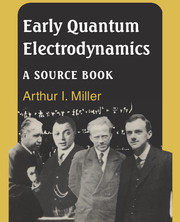Book contents
- Frontmatter
- Contents
- Preface
- Notes to the Preface
- Acknowledgements
- Notes to the Reader
- I Frame-setting essay
- 1 From quantum mechanics toward quantum electrodynamics
- 2 Second quantization
- 3 Photons and relativistic electrons
- 4 Quantum electrodynamics
- 5 Theories of the nuclear force in the 1930s
- Epilogue
- Notes
- References to the Frame-setting essay
- II Selected papers
- Index to Frame-setting essay
5 - Theories of the nuclear force in the 1930s
Published online by Cambridge University Press: 05 August 2012
- Frontmatter
- Contents
- Preface
- Notes to the Preface
- Acknowledgements
- Notes to the Reader
- I Frame-setting essay
- 1 From quantum mechanics toward quantum electrodynamics
- 2 Second quantization
- 3 Photons and relativistic electrons
- 4 Quantum electrodynamics
- 5 Theories of the nuclear force in the 1930s
- Epilogue
- Notes
- References to the Frame-setting essay
- II Selected papers
- Index to Frame-setting essay
Summary
Heisenberg invents exchange forces in nuclear physics: the metaphor of forces transmitted by particles
In a series of papers in 1932–3 entitled, ‘On the structure of the atomic nucleus. I,’ ‘II’, ‘III’, Heisenberg sought to frame a theory of the nuclear force based on the newly discovered neutron and which was applicable to the origin of the electrons in β-decay.
Introducing the neutron into the nucleus, wrote Heisenberg in (1932a), leads to an ‘extraordinary simplification for the theory of the atomic nucleus’. The existence of the neutron permitted him the means to relate the problem of β-decay to the form of the attractive force that binds the nucleus. As Heisenberg wrote to Bohr on 20 June 1932, ‘The basic idea is to shift the blame for all principal difficulties onto the neutron [divergent self-energies too] and to refine quantum mechanics in the nucleus’ (Pauli, 1985).
But first Heisenberg had to decide whether the neutron was a composite particle consisting of a proton and an electron or a fundamental particle. In either case, Heisenberg assumed that the neutron had spin ½ in order to provide N with the correct statistics, that is comprising seven protons and seven neutrons, an even number of fermions. But according to the uncertainty principle, the neutron could not be a proton–electron bound state because the composite neutron's binding energy would have to be of the order of 137mc2 (m being the mass of the electron), which is one hundred times greater than the measured neutron–proton mass difference (Heisenberg, 1932b).
- Type
- Chapter
- Information
- Early Quantum ElectrodynamicsA Sourcebook, pp. 84 - 96Publisher: Cambridge University PressPrint publication year: 1994



